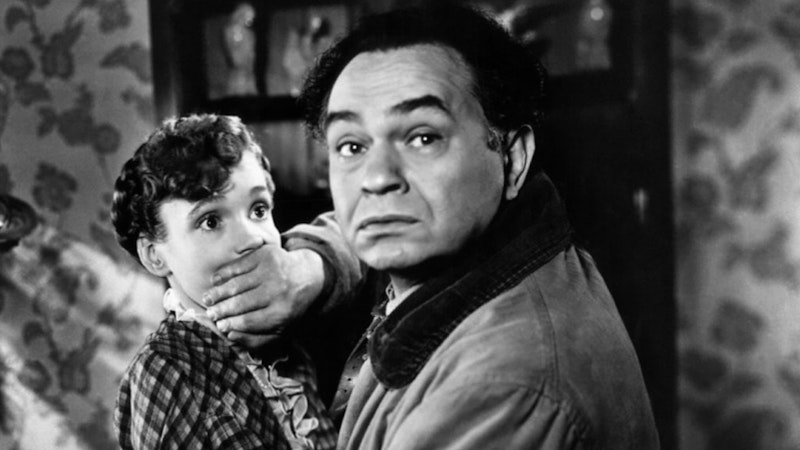Delmer Daves’ 1947 film The Red House isn’t easy to categorize. At once a thriller, film noir, and gothic horror, it makes a good aesthetic pairing with Charles Laughton’s The Night of the Hunter, despite the fact that Laughton’s masterpiece was made eight years later. Perhaps its oddness is because it was independently produced by Edward G. Robinson and Sol Lesser through Thalia Productions (often low-budget productions, especially of that time period, ended up with cinematic gems, both intentionally and unintentionally).
Robinson plays the lead—Pete Morgan, an older farmer with a wooden leg, who lives in isolation from the small town with his sister, Ellen (the great Judith Anderson), and their adopted daughter, Meg (Allene Roberts). There’s something strange and perhaps sinister about the Morgan family. They keep to themselves, which in a small town is reason enough to concoct various rumors about them.
Life is pretty much the same on the Morgan farm until Meg persuades Pete to hire Nath Storm (Lon McCallister) to help out. There’s a budding romance between Nath and Meg, and Pete’s aware of this. As much as he accepts Nath as a hired help, Pete’s still protective of Meg. This may be construed as a fatherly love, but Pete’s an unusual man.
Beyond the house are the woods. Pete constantly warns Meg to not explore the woods, especially the red house that’s overgrown with large bushes and surrounded by sinister trees. But the fruit’s naturally always more interesting when it’s forbidden, and with Nath’s help, Meg decides to explore.
The mystery of the red house is slowly revealed, although it’s not very difficult to guess that Pete committed a crime, that Meg’s an unfortunate victim of Pete’s crime, and that Pete’s a mad tyrant that keeps control of both Meg and Ellen. In many ways, the mystery’s secondary in the film; rather, the atmosphere and the relationships between people in the small town create one revelation after another.
Coupled with Miklós Rózsa’s haunting score that renders the woods more frightening than they are, The Red House is a film about repression, both sexual and metaphysical. The sexual innuendos flow through the film, and what binds them together is Pete’s own repressed madness.
Meg and Nath are always thwarted in their consummation of eros; Ellen regrets allowing herself to be controlled by Pete and miss out on the great love affair with the town’s doctor (Anderson’s dressed as a spinster, although she’s not as a sinister as Mrs. Danvers in 1940 Rebecca); Nath’s mother suppresses her desire to get re-married; Teller (Pete’s handyman who’s paid to keep everyone out of the woods played by Rory Calhoun) is reverberating with erotic energy as he forces himself on Tibby (the beautiful Julie London), who doesn’t seem to mind the sadistic sexual roughness especially in the contrast to Nath’s “proper wooing” strategy.
There’s even an implication of incest. Pete and Meg are awfully close together, and banter between Nath and his mother (as well as their farewell kiss that goes beyond motherly love) implies a familiarity that’s too uncomfortable to even imagine. In the midst of all of this, what stands out is Edward G. Robinson’s performance as the twisted man, who couldn’t possess the woman he allegedly loved. On the surface, Pete’s aware of his madness but he can’t help but exert control over everyone, especially Meg. He sees someone else in her and often enters into a displacing trance.
As usual, Robinson’s flawless. He moves swiftly from Pete’s pretense of normalcy to authentic madness and hatred for everyone and everything that represents creation and rebirth. In one moment, we pity him (Robinson’s anguish and tears are all too real); in another, we want to see him annihilated. He’s not a simple villain however, and this may not be due to the script but mainly to Robinson’s inherent gift for depth and nuance.
Bert Glennon’s cinematography enhances Robinson’s interpretation of Pete’s inner life. Glennon served as a cinematographer for directors, such as John Ford and Josef von Sternberg, and without a doubt, his camera illuminates the interior lives of the characters. When Pete becomes sinister, he’s often covered in darkness, yet Robinson’s stature and shape are eerily recognizable.
Similarly, Meg’s always followed by darkness and shadows in her constant attempts to enter into the light. The past is hovering above her. She’s tired of “being good” and wants to break out of the monotony of her life on the farm. In this case, Nath seems to be the best option to exit the darkness, and enter into the light, but is Nath the safe harbor that he’s purporting to be?
Nothing is as it seems in The Red House, and as much as Meg and Nath want to “look forward” into life, the ending remains uneasy. Meg and Nath’s “happiness” may not be able to be fulfilled in the same place, even after the burning of the past.

